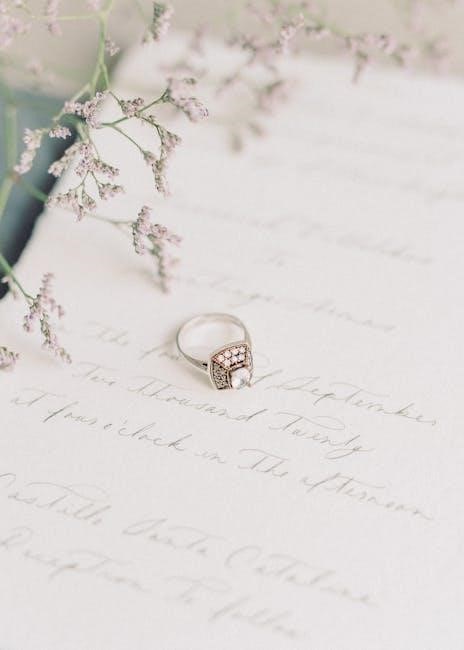O-ring design is critical for ensuring proper sealing in various industrial applications. These circular elastomeric rings are designed to seal gaps between two components, preventing fluid or gas leakage. Proper design ensures reliability, durability, and optimal performance in both static and dynamic environments.
What is an O-Ring?
An O-ring is a circular elastomeric seal used to prevent leakage between two components. Typically made of rubber or thermoplastic materials, it is designed to fit snugly into a groove, ensuring a tight seal under various pressures. O-rings are versatile, operating effectively in both static and dynamic applications across industries like aerospace, automotive, and industrial systems. Their reliability in maintaining sealing integrity makes them a critical component in modern engineering.
Importance of Proper O-Ring Design
Proper O-ring design is crucial for ensuring reliable sealing performance. A well-designed O-ring prevents leakage, maintains system integrity, and withstands operational stresses. Incorrect dimensions or material choices can lead to premature failure, compromising safety and efficiency. Accurate design ensures optimal sealing, extends component longevity, and minimizes maintenance costs. It is essential for achieving consistent performance in industrial, aerospace, and automotive applications, where failure can have serious consequences.

Materials and Properties
O-rings are typically made from elastomers like nitrile, silicone, fluorocarbon, and Viton. Each material offers unique properties such as temperature resistance, chemical compatibility, and durability, ensuring optimal performance in specific applications.
Common Elastomers Used in O-Rings
Nitrile (NBR), silicone (VMQ), fluorocarbon (FKM), and Viton® are the most common elastomers used in O-rings. Nitrile offers excellent resistance to oils and fuels, making it ideal for industrial applications. Silicone provides superior temperature resistance and flexibility, suitable for high-heat environments. Fluorocarbon excels in aggressive chemical environments, while Viton® is chosen for extreme temperature and chemical resistance. Each material is selected based on its specific properties to ensure optimal performance in various sealing applications.
Material Selection Based on Application
Material selection for O-rings is crucial and depends on the specific application requirements. Nitrile (NBR) is ideal for oil and fuel resistance, while silicone (VMQ) excels in high-temperature environments. Fluorocarbon (FKM) and Viton® are chosen for aggressive chemical exposure. Each material’s properties, such as temperature range, chemical compatibility, and durability, must align with the operating conditions to ensure optimal sealing performance and longevity in industrial, automotive, or aerospace applications.

Dimensions and Tolerances

O-ring dimensions and tolerances are critical for ensuring proper fit and sealing performance. Precise measurements of inner diameter, cross-section, and groove dimensions are essential for optimal functionality.
Standard O-Ring Sizes and Dimensions
Standard O-ring sizes are defined by their inner and outer diameters, as well as their cross-sectional thickness. Common sizes range from 1/32 to 26 inches in inner diameter, with cross-sections typically between 1/32 and 1/4 inch. These dimensions are standardized under specifications like AS568, ensuring interchangeability and compatibility across manufacturers. Proper sizing is critical for maintaining the seal’s integrity and functionality in various applications.
Understanding Tolerances in O-Ring Design
Tolerances in O-ring design refer to the acceptable dimensional variations in the O-ring and its groove. These tolerances are critical to ensure proper sealing and functionality. Excessive tolerance can lead to leakage or improper compression, while insufficient tolerance may cause deformation or failure. Factors like application requirements and material properties influence tolerance levels, ensuring optimal performance and longevity of the seal;

Groove Design Considerations
Groove design is pivotal in O-ring sealing efficiency. Key considerations include material compatibility, application type, and precise dimensional alignment to ensure optimal performance and longevity of the seal.
Basic Principles of O-Ring Groove Design
The foundation of effective O-ring groove design lies in balancing compression, material compatibility, and dimensional accuracy. Groove dimensions must align with the O-ring’s cross-sectional diameter, ensuring proper sealing without excessive deformation. Surface finish and chamfers are critical to prevent damage during installation. Additionally, the groove’s depth and width should accommodate the O-ring’s elasticity, ensuring optimal sealing in both static and dynamic applications. Proper design prevents leakage and extends the seal’s lifespan.
Groove Dimensions and Surface Finish
Groove dimensions must precisely match the O-ring’s size to ensure proper sealing. The diameter and depth of the groove are critical, as incorrect measurements can lead to insufficient compression or excessive stress. A smooth surface finish, typically between 0.1 to 0.3 µm, prevents O-ring abrasion and ensures optimal sealing. Chamfers or radii on groove edges further enhance installation and prevent damage. Proper groove design and finish are essential for reliable performance and extended seal longevity.
Calculating Squeeze and Compression
Squeeze is the difference between the O-ring’s inner diameter and the groove diameter. Proper calculation ensures optimal sealing without excessive deformation, enhancing performance and longevity.
Understanding Squeeze in O-Ring Applications
Squeeze refers to the compression of an O-ring within its groove, ensuring proper sealing. It is calculated as the difference between the O-ring’s inner diameter and the groove diameter. Proper squeeze ensures the O-ring deforms adequately to fill gaps, preventing leakage. Excessive squeeze can lead to premature wear, while insufficient squeeze may result in inadequate sealing. The ideal squeeze depends on the application, with dynamic applications requiring tighter tolerances to maintain integrity under movement or pressure changes. Ensuring the correct squeeze is critical for optimal performance and longevity of the seal.
Calculating Compression for Proper Sealing
Compression is the deformation of an O-ring under load, ensuring sealing integrity. It is calculated by subtracting the groove diameter from the O-ring’s inner diameter. Proper compression ensures the O-ring fills the groove evenly, preventing leakage. Excessive compression can cause premature wear, while insufficient compression may fail to seal effectively. The ideal compression range is typically between 10% to 30%, depending on the application. Accurate calculation ensures optimal sealing performance and longevity.
Surface Finish and Its Impact
Surface finish is crucial for maintaining a proper seal. It prevents O-ring abrasion and ensures optimal performance. A suitable finish ensures durability and effectiveness in sealing applications properly.
Importance of Surface Finish in Sealing
A smooth surface finish is essential for effective sealing. It minimizes abrasion and ensures even compression, preventing leakage. A rough finish can damage the O-ring and compromise the seal, leading to premature wear. Proper surface finish ensures optimal contact and longevity of the O-ring, making it a critical factor in maintaining sealing integrity across various applications and environments.
Recommended Surface Finish Parameters
For optimal sealing, the recommended surface finish for O-ring grooves is typically a Ra value of 0.5 to 1.5 micrometers. A smoother surface ensures better sealing performance by minimizing leakage and reducing wear on the O-ring. Rough surfaces can lead to premature wear and compromised sealing. The finish should also be perpendicular or parallel to the direction of the seal to ensure proper contact and avoid leakage in both static and dynamic applications.
Applications and Use Cases
O-rings are widely used in aerospace, automotive, hydraulic, and industrial applications. They provide reliable sealing in both static and dynamic environments, ensuring optimal performance across diverse industries.
Static vs. Dynamic Applications
In static applications, O-rings remain stationary, sealing gaps between fixed components, often in low-pressure environments. Dynamic applications involve moving parts, requiring O-rings to withstand friction and wear while maintaining a tight seal. Material selection is critical, as dynamic conditions demand higher durability and resistance to abrasion. Understanding these differences ensures proper O-ring choice, optimizing performance and longevity in diverse industrial and hydraulic systems, where reliability is paramount to prevent leakage and maintain operational efficiency.
Common Industries Using O-Rings
O-rings are integral to various industries due to their reliable sealing capabilities. The automotive industry utilizes them in engines and fuel systems to prevent leakage. Aerospace relies on O-rings for high-pressure and high-temperature applications. Oil and gas industries employ them in drilling and refining processes to maintain sealing integrity. Chemical processing plants use resistant materials to withstand harsh environments. Food and beverage, as well as pharmaceutical industries, require sanitary conditions, making O-rings indispensable. These industries depend on O-rings for durability and consistent performance, ensuring operational efficiency and safety.

Installation and Maintenance
- Proper installation ensures O-ring longevity and optimal sealing performance.
- Lubrication prevents wear and ensures smooth operation.
- Regular inspections and cleaning prevent contamination.
- Avoid using sharp tools to prevent damage;
Best Practices for Installing O-Rings
Ensure surfaces are clean and free from contaminants before installation. Use calibrated tools to avoid stretching or twisting the O-ring. Avoid using sharp objects that may cause damage. Lubricate the O-ring with compatible fluid to ease installation. Align the O-ring properly with the groove to prevent misplacement. Handle O-rings with clean, dry hands or gloves to prevent oil or dirt transfer. Inspect for any signs of damage before fitting. Follow manufacturer guidelines for specific applications. Proper installation ensures optimal sealing performance and extends service life.
Maintenance Tips for Longevity
Regularly inspect O-rings for signs of wear, such as cracks or discoloration. Clean O-rings with compatible solvents to remove dirt or debris. Avoid excessive heat or chemical exposure. Store O-rings in a cool, dry place, away from direct sunlight. Lubricate O-rings periodically with compatible fluids to maintain flexibility. Replace O-rings at the first sign of degradation to prevent leaks. Proper care extends their lifespan and ensures consistent sealing performance.

Common Mistakes to Avoid
- Overlooking material compatibility with fluids or temperatures.
- Using incorrect groove dimensions or tolerances.
- Neglecting surface finish requirements.
- Improper installation causing uneven compression.
Overlooking Material Compatibility
One of the most critical mistakes is ignoring material compatibility with the operating environment. Using an O-ring made from a material that isn’t resistant to the application’s chemicals, temperatures, or pressures can lead to premature degradation and failure. Always ensure the elastomer is compatible with the fluids, gases, and environmental conditions present. Failure to do so can result in leaks, reduced service life, or even system damage. Proper material selection is essential for reliable performance.
Incorrect Groove Dimensions
Incorrect groove dimensions are a common mistake that can lead to poor sealing performance or O-ring failure. Groove depth and diameter must align with the O-ring size to ensure proper compression and sealing. If the groove is too shallow or narrow, the O-ring may not seat correctly, leading to leakage or inadequate sealing. Conversely, oversized grooves can cause excessive stress on the O-ring, reducing its lifespan. Always refer to standardized groove design guides to ensure accuracy and reliability in your application.